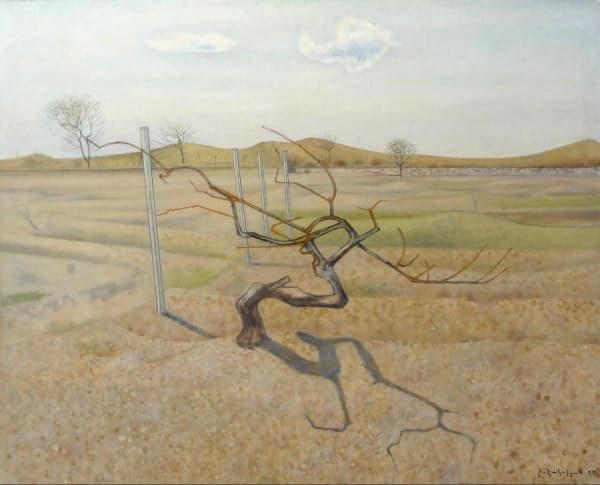Hagop Hagopian
With the vanishing pinks of trees that have just completed their flowering, the burgeoning emerald of a tiny shrub, the limpid, crystalline blue of the Armenian sky, the earth, stones, trellised vineyards, and delicate branches replete with anticipation and ethereal quivers, Hagop Hagopian captures the ethos and spirit of the Armenian countryside in his art. Working within a unique style that is often praised for its pursuit of perfection, the artist uses a linear approach to composition where simple, geometric shapes and pale, subdued colors reflect a certain austerity of sentiment that visually translates Hagopian’s intensive devotion to his native soil.
Hagop Hagopian (b. 1923, Alexandria, Egypt) is considered as one of the most important Armenian artists of the past century. His family fled to Egypt during the Armenian Genocide in 1915 and while in Egypt he would paint from the painful life of his compatriots who escaped the Genocide. In 1944, Hagopian moved to Cairo to study at the Cairo Academy of Fine Arts and in 1952 he was sent to Paris to continue his studies in art under André l’Hote. Hagopian’s works are included in numerous public and private collections, including The Museum of Fine Arts, (Cairo, Egypt); The National Gallery of Armenia, (Yerevan, Armenia); Zimmerly Art Museum, (New Brunswick, NJ); Georgia State Museum of Arts, (Tbsili, Georgia); National Art Museum of Ukraine, (Kiev, Ukraine).
-

Hagop Hagopian
Mannequins and Landscapes 30 Juin - 16 Septembre 2023Tufenkian Fine Arts is pleased to announce, Hagop Hagopian: Mannequins and Landscapes , a solo exhibition of paintings and watercolors by Hagop Hagopian. This exhibition will feature Hagopian’s mannequin paintings...Lire plus -

Hagop Hagopian
Online Exclusive 13 Mai - 25 Juin 2022Tufenkian Fine Arts is pleased to present, Hagop Hagopian , an online exclusive presentation spanning the artist's formative years in the 1980s to his more mature style in the mid...Lire plus -

Tribute: Works on Paper
20 Novembre - 23 Décembre 2020Tufenkian Fine Arts is pleased to present Tribute: Works on Paper, a group exhibition including works by Garo Antreasian, Hagop Hagopian, Varujan Boghosian, and Reuben Nakian. The exhibition will be...Lire plus












